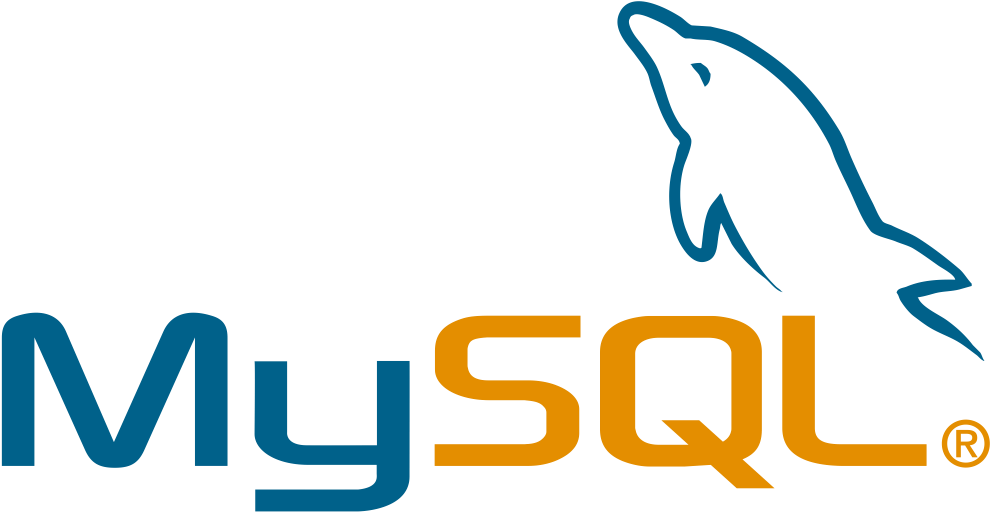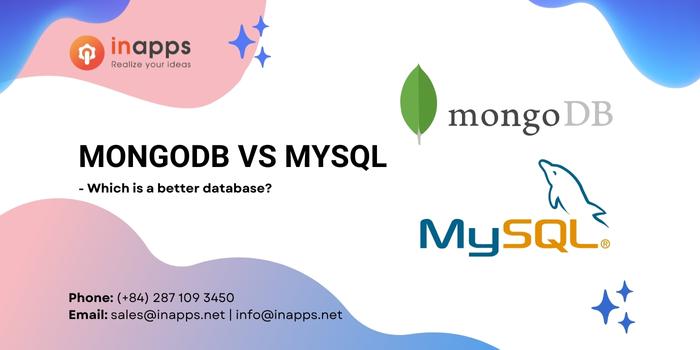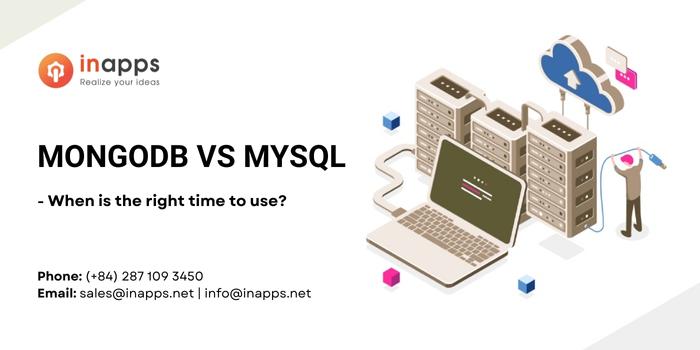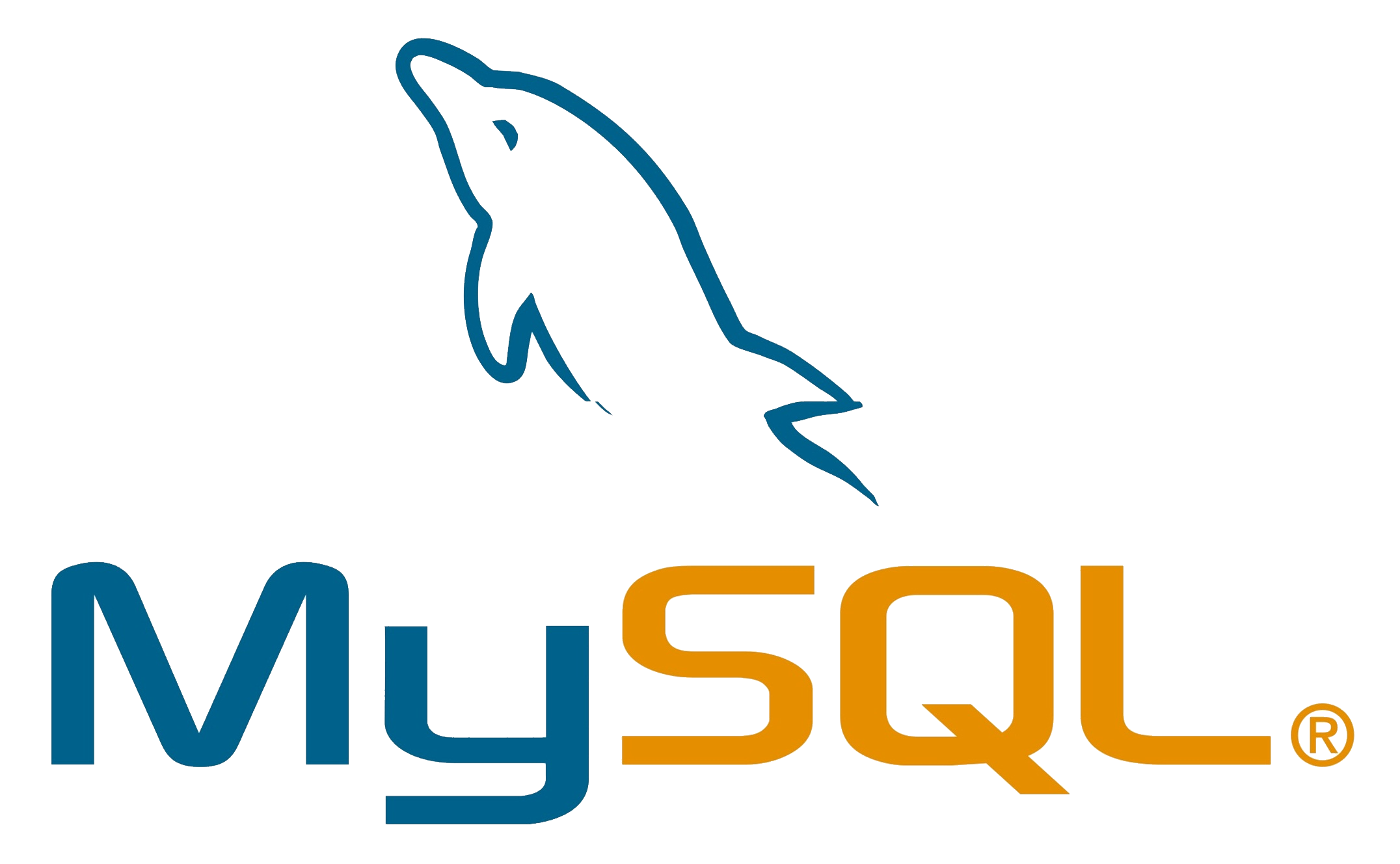- Home
- >
- Software Development
- >
- MongoDB vs MySQL – Which is a better database?
The hot topic of the year 2022: MongoDB vs MySQL.
For years, relational databases were leading the market and the option was very apparent at that time, that is, either MySQL, Oracle, or MS SQL. They have served as the basis for thousands of enterprise applications, though digital apps need more versatility and usability.
Non-relational databases such as MongoDB have proven to fulfill the current requirements while replacing the current relational setting.
For organizations across the world that need a relational database, MySQL is becoming an affordable choice. Non-relational databases such as MongoDB, however, have emerged to meet the modern needs of our fluid data as the range and amount of data have risen significantly.
We are going to discuss MongoDB vs MySQL in this article. Let us start by learning about each one of the databases individually before diving into the comparison.
What is MongoDB?
MongoDB is a renowned document-oriented open-source database created by 10gen, currently known as MongoDB Inc. Here, the documents are generated and kept in BSON files, Binary JSON format, making it support all JS types of data.
Apart from that, MongoDB is also used for projects that use Node.js. In addition, JSON makes use of a human-readable format to transfer data between servers and web apps.
In terms of storage capacity and speed, it is also a good choice, as it provides better performance and effectiveness.
One of the top advantages provided by MongoDB is the use of dynamic schemas, such as fields or value types, that remove the need to pre-define the structure.
This model facilitates the portrayal of hierarchical relationships, array storage, and the power to alter the structure of records by simply adding or removing fields.
This NoSQL solution for improved scalability and high reliability deals with embedding, auto-sharding, and onboard replication.

What is MySQL?
MySQL is an open-source Relational Database Management System (RDBMS) that operates mainly on the relational database model. It makes the management of databases simpler and more versatile. MYSQL’s source code is available under the GNU GPL and Oracle Corporation owns and maintains the project.
You have to pre-define your database schema in MySQL centered on your specifications and establish rules that help you regulate the relationships in your tables between fields.
It collects data in tables that are grouped into a database and makes use of Structured Query Language (SQL) to access data and commands such as ‘SELECT’, ‘UPDATE’, ‘INSERT’ and ‘DELETE’ to handle it.
Similar data can be stored in multiple tables, and you can conduct queries across different tables and minimize the risk of data replication by using the JOIN operation.

MongoDB vs MySQL – The Features
Features of MongoDB
- MongoDB offers an aggregation feature to use it in an efficient manner.
- MongoDB uses BSON (Binary JSON) format.
- MongoDB has come up with the Sharding feature.
- It can be used as a file system with load balancing and data replication features
- MongoDB supports field, range queries, regular expression searches.
- MongoDB is a schema-less database (written in C++) which makes it flexible.
- Indexes are built to enhance the performance of searches.
- It has MongoDB Management Service, a web tool that enables tracking of databases and machines and backs up the data.
- MongoDB supports multiple storage engines, such as WiredTiger Storage Engine and MMAPv1 Storage Engine.
- MongoDB has a rich Query Language, supporting all the major CRUD operations.
Features of MySQL
- MySQL is a relational database system.
- MySQL follows the working of a client/server architecture.
- It holds the ACID property and also allows distributed multi-version support.
- MySQL runs high-speed master/slave replication configurations and it offers cluster servers.
- It can be used on any platform and provides 24*7 support for open source and enterprise editions.
- MySQL is easy and absolutely free to use.
- MySQL has a solid data security layer that protects sensitive data from intruders.
- MySQL is compatible to run on many operating systems, like Novell NetWare, Windows, Linux, and many varieties of UNIX.
- Its efficiency is high since it has a very low memory leakage problem.
- MySQL enables transactions to be rolled back, commit, and crash recovery.
MongoDB vs MySQL – The Comparison
Now that we have learned about each one of them individually, let us focus on what and how they perform when compared to each other. Let’s get started, shall we?

Speed & Efficiency
The ability to manage huge unstructured data is a key advantage MongoDB has over MySQL. It is inherently quicker because it helps users to query in a particular way that is more workload-sensitive.
Developers claim that when it comes to handling massive databases, MySQL is somewhat slower when compared to MongoDB. It is not able to deal with huge and unstructured quantities of data.
Replication
MongoDB is just supporting master-slave replication. To make multiple copies of the data, it utilizes replica sets. At any point along the way, each member of this replica set will be allocated a primary or secondary function.
Read/write is performed on primary replicas by default and then is made to replicate on secondary replicas.
Both master-slave and master-master replication are being supported by MySQL. Multi-source replication gives you the potential to replicate data from multiple masters in parallel. Uniformity is not too complicated in master-slave replication, since every bit of data has exactly one owing master.
Whereas in master-master replication, they can deliver anything you want with no single point of failure if you understand how to work around it.
Flexibility of Schema
The fact that there are no limitations on schema design is the greatest advantage to MongoDB. Within a collection, you may drop a few documents and it is not important for these documents to have any relations. The only limitation to this is the supporting data structures.
You might need to consistently optimize the schema depending on how the application can access the data because of the lack of Joins and transactions.
However, you need to properly identify tables and columns before you can store something in MySQL, and every row in your table needs to have the same column. And because of this, if you pursue normalization, there’s not much room for flexibility in the way of storing data.
Querying Language
The unstructured query language is used by MongoDB. To create a query in JSON documents, you need to define a document with a property that you want the results to align with.
Usually, it is performed using a very extensive set of operators using JSON that are linked to each other. Each property is viewed by MongoDB as having an implied Boolean AND. Boolean OR queries are natively assisted, but to accomplish this, you must use a special operator ($or).
To interact with the database, MySQL uses the structured query language. It is also a very strong language, considering its simplicity, consisting primarily of two parts: data definition language and data manipulation language.
Sharding
MongoDB sharding has the potential to divide a collection into sub-sets of data to store them through several shards. This helps the application to expand even more than the resource limits of a standalone server or replica set.
Also, to optimize the usage of storage space and seamlessly load balance queries, it can manage the distribution of data to any number of nodes. It also allows automatic failure and redundancy for users.
Unlike MongoDB, there is no standard sharding implementation for MySQL. Although MySQL provides two sharding methods, that is, MySQL Cluster – built-in Automatic sharding functionality and MySQL Fabric, official sharding framework, they are only sometimes deployed. The standard practice is to carry out your own sharding system just like Facebook did.
The decision of designing for the sharding key, schema adjustments, and mapping among sharing the key, shards, and physical servers must be made by database administrators. The incorrect decision of sharding key can lead to system inflexibility also making this decision kind of an important one.
Relationships
MongoDB does not support JOIN. On the other hand, multi-dimensional forms of data such as arrays and even other documents are supported by MongoDB. Putting one document in the other one is called embedding.
The JOIN operations are one of the greatest things about MySQL. JOIN renders the relational database relational, to be explained in easy words. With the support of a single SELECT command, JOIN allows any individual to link data from two or more tables into a single query.
Security
MongoDB makes use of role-based access control with a versatile range of privileges. Authentication, auditing, and authorization are among the security features in this database.
In addition, the use of Transport Layer Security and Secure Sockets Layer for encryption purposes can also be made to use here. It’ll make sure that only the intended users can access to read it.
MySQL utilizes a security model that is privilege-based. This implies that it validates a user and provides it with user privileges on a specific database including ‘CREATE’, ‘SELECT’, ‘INSERT’, and much more.
Nevertheless, it fails to address why specific access is denied to a particular individual. Encrypted links between the clients and the server using SSL are used on the transport layer.
When to use MongoDB vs MySQL?
There are several factors but the two of them are the top-most priority when it comes to opt between noSQL and relational databases: how static is your data and how plug-and-play the tool exactly will be for your dedicated team.

How frequently the data gets updated?
Basically, a project with modified data will help more a relational database than a non-relational one. There’s an example of such a project which is a sort of transactional system, such as a workflow application, an ecommerce platform, or a payment processor.
While on the other hand, a project that has no updated information like analytics information where data doesn’t alter after it has been gathered, will provide perks more from a relational database.
Ease of use
There’s a thing that you should remember when building the ability of your team to work with a product. Here, MySQL has a certain advantage over MongoDB. We all know that SQL stands for Standard Query Language. Now,m we are stressing a little over the word standard here.
As you already have an application built to work with MySQL, the entire cost of migrating to a separate product is minimal.
The following query will be properly executed just fine in MySQL, PostgreSQL, SQLite, Oracle, and so on:
SELECT *
FROM users
WHERE username="mchojrin";This clearly defines if your development team is not that well in MySQL but they have a great experience working with some other SQL database, then chances are they will pick up speed swiftly.
Also, if you wish to execute a similar query employing MongoDB, you will surely have to issue a command as below:
db.user.findOne({name: "mchojrin"});That specific command will be unique if you select CouchDB or some other noSQL database. The same goes for other sorts of queries like update, insert, delete, and so on.
So if you’re considering switching databases on a project that’s already in production, take a minute or two to decide whether the benefits you’ll get are worth the cost of rewriting important parts of the code.
MongoDB vs MySQL – The Difference
Now that we have understood both MongoDB and MySQL, let us have a look at the differences to get an even clear and more precise picture of both the databases.
 |  |
| It displays data as a collection of JSON documents. | It displays data in tables and rows. |
| It uses object querying. | It is a structured query language. |
| Less risk of attack due to its design. | The risk of SQL injection attacks is there. |
| It is an ideal option if you have structured and/or unstructured data with the potential for quick growth. | It is an ideal option if you have structured data and need a traditional relational database. |
| High availability, scalability, replication, and sharding are inbuilt. | No efficient replication and sharding are available. |
| MongoDB uses Collection, Document, Field, Embedded Document, Linking, etc. | MySQL uses Table, Row, Column, Joins, etc. |
Bottom Line- Which one to go for?
With its flexible and easy concepts, as well as the friendly and supportive community, MongoDB offers convenience to the users, while after Oracle’s acquisition, users claim to have experienced the complete opposite with MySQL.
Another problem with the latter is the emphasis of the owner on the growth of MariaDB, along with the reluctance to acknowledge community patches and have a sustainability plan. These parameters have culminated in a grinding halt, but for many businesses worldwide, MySQL still proves to be their one-stop solution to all the database needs.
Comparing the speed of MongoDB vs MySQL, developers claim that MySQL has certain issues due to the massive data volumes and it also lacks speed, so it would be a better option for businesses with smaller databases and searching for a more general solution.
Although this is one of MongoDB’s benefits over MySQL, it is the ability to work with large and unstructured volumes of data.
With InApps, you will be at the top of your game at all times.
FAQs
1. Why use MongoDB instead of SQL?
MongoDB is faster than MySQL due to its ability to handle large amounts of unstructured data when it comes to speed. It uses slave replication, master replication to process vast amounts of unstructured data and offers the freedom to use multiple data types that are better than the rigidity of MySQL.
2. Should I learn MySQL or MongoDB?
MySQL is an excellent choice if you have structured data and need a traditional relational database. MongoDB is well-suited for real-time analytics, content management, the Internet of Things, mobile, and other types of applications.
3. Can MongoDB replace MySQL?
MySQL, MS SQL Oracle, and Server are nearly synonymous with RDBMS, but MongoDB is a cross-platform document-oriented and NoSQL database. At times, it can be a wise decision to replace MySQL with MongoDB. It is a nimble database that allows fast changes of the cognitive framework when apps evolve.
4. Is MongoDB a relational database?
MongoDB is a non-relational database that offers scalability, high performance, reliability, and flexibility. MongoDB has grown into a wider data platform with MongoDB Atlas, MongoDB’s cloud-based database, which makes data available at all times.
5. Why is MongoDB so popular?
MongoDB is popular because it’s easy to learn and get started. Yes, it’s highly scalable (auto-sharding, anyone?), cost effective and more. But the biggest reason MongoDB is wildly popular, in my experience? Because MongoDB enables profound developer agility through its flexible data model.
6. What is MongoDB best used for?
MongoDB works best with unstructured data, so it’s great for Big Data systems, MapReduce applications, news site forums, and social networking.
List of Keywords users find our article on Google
Let’s create the next big thing together!
Coming together is a beginning. Keeping together is progress. Working together is success.


















